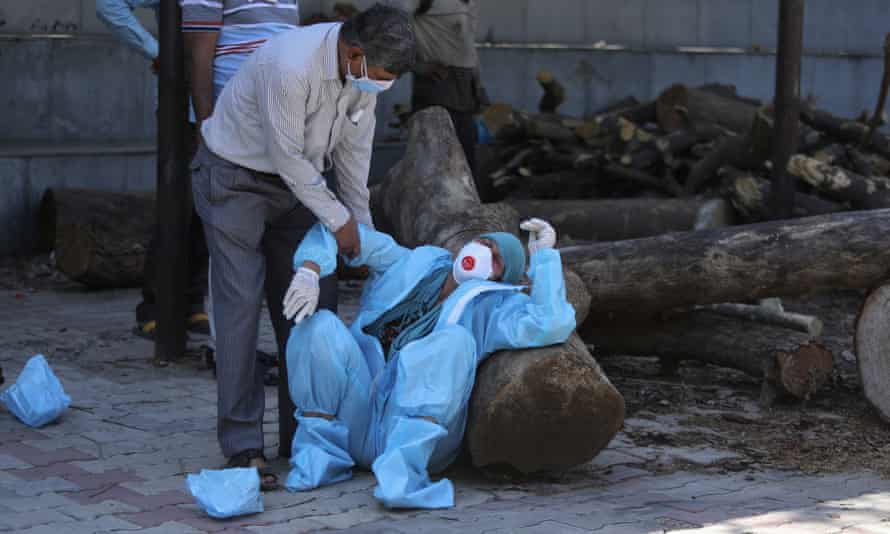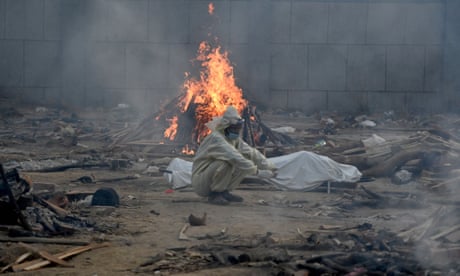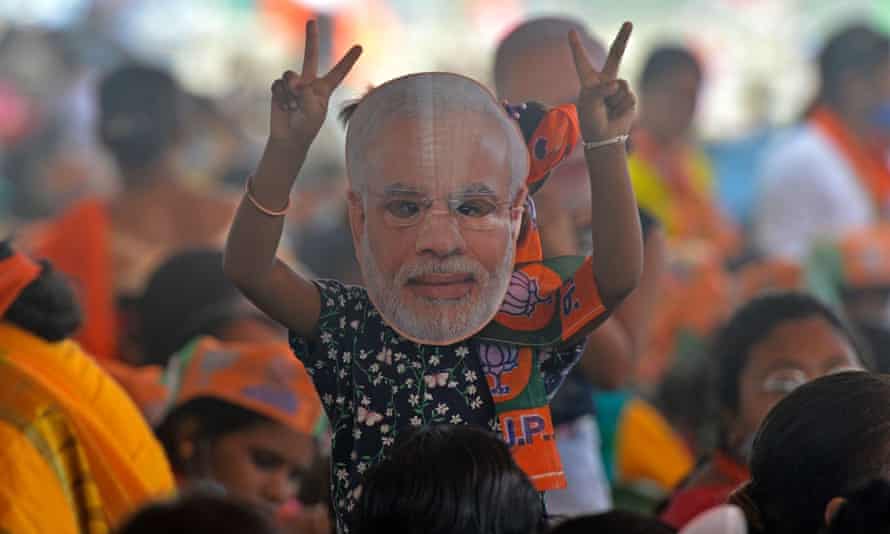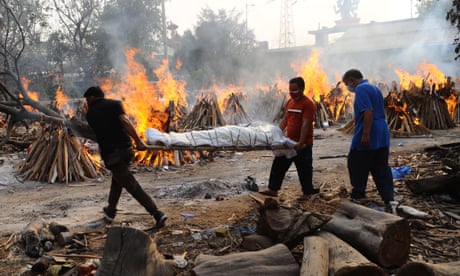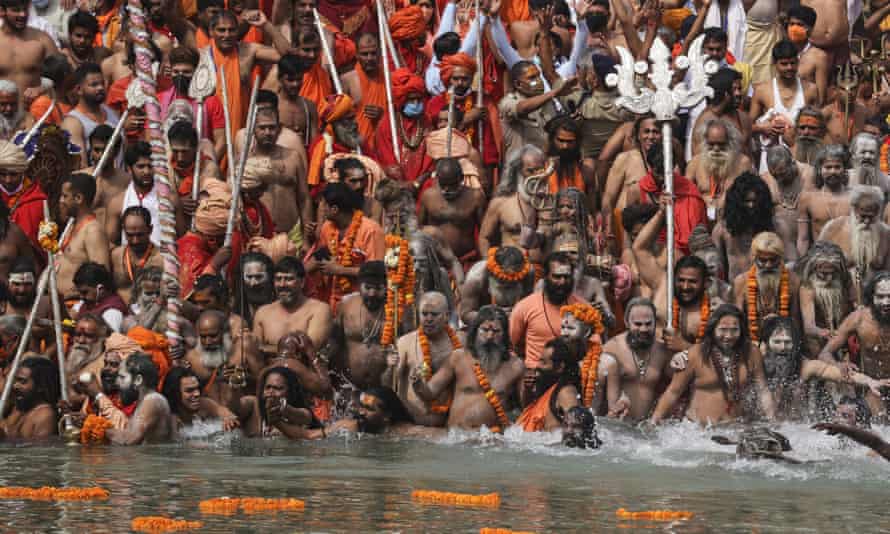'Prime Minister Narendra Modi could have prevented India's devastating Covid-19 crisis, critics say. He didn't
MODI MASS MURDERER
By Julia Hollingsworth, CNN
(CNN) On April 17, ahead of a state election, a maskless Prime Minister Narendra Modi boasted to a sea of cheering supporters: "I've never ever seen such huge crowds at a rally."
His country was on the brink of a humanitarian crisis. That day, India recorded more than 261,000 new coronavirus cases -- more than many countries have seen during the entire pandemic.
And it was only going to get worse. Each day since April 22, the country has reported more than 300,000 new cases -- at times, up to half of the daily cases reported globally. The capital New Delhi is now running out of wood for cremations. Hospitals are full and lacking oxygen. Only 2% of the population has been fully vaccinated. Foreign leaders are now rushing to India's aid.
While Modi's Hindu nationalist Bharatiya Janata Party (BJP) spokesman Narendra Taneja told CNN this week that responsibility for India's second wave belonged "first and foremost" to the government, he maintained the crisis could not have been foreseen -- despite countless countries being battered by second waves as new variants emerged globally.
Others in Modi's orbit have argued state governments are to blame for not imposing regional lockdowns and mismanaging their health care systems. Last weekend, Health Minister Harsh Vardhan said oxygen shortages at hospitals were a problem not of supply but distribution, which he claimed was the responsibility of state governments.
But many in India believe responsibility lies with Modi and his Hindu nationalist government, which not only didn't prepare for a second wave but also encouraged mass gatherings at Hindu festivals and political rallies, including in a closely contested battleground state.
"The government has failed us all," Priyanka Gandhi Vadra, the general secretary of opposition party Indian National Congress, said in a statement this week. "Even those of us who oppose and fight them could not have foreseen a complete abdication of leadership and governance at a time as devastating as this."

Photos: India's Covid-19 crisis
People line up for vaccines at an indoor stadium in Guwahati on April 22.
Hide Caption
16 of 30

Photos: India's Covid-19 crisis
A relative of a Covid-19 victim breaks down during a cremation in New Delhi on April 20.
Hide Caption
17 of 30

Photos: India's Covid-19 crisis
Police officers patrol a deserted street in New Delhi on April 20. The capital city has been on lockdown because of Covid-19.
Hide Caption
18 of 30

Photos: India's Covid-19 crisis
Signs inform people that a vaccination center in Mumbai was out of vaccines on April 20.
Hide Caption
19 of 30

Photos: India's Covid-19 crisis
Migrant workers crowd the Kaushambi bus station on April 19. They were trying to return home after a lockdown order was announced in the capital.
Hide Caption
20 of 30

Photos: India's Covid-19 crisis
A woman waits to receive a Covid-19 vaccine in Mumbai on April 18.
Hide Caption
21 of 30

Photos: India's Covid-19 crisis
Relatives of a Covid-19 victim mourn for their loved one outside a government hospital in Ahmedabad on April 17.
Hide Caption
22 of 30

Photos: India's Covid-19 crisis
Migrant workers line up at a railway station to leave Mumbai ahead of a lockdown on April 14.
Hide Caption
23 of 30

Photos: India's Covid-19 crisis
People gather at a Srinagar mosque on the first day of Ramadan on April 14.
Hide Caption
24 of 30

Photos: India's Covid-19 crisis
A Hindu priest puts a face mask on an idol of the Goddess Ashapura during Navaratri celebrations in Beawar on April 13.
Hide Caption
25 of 30

Photos: India's Covid-19 crisis
Hindu holy men wade into the Ganges River during the Kumbh Mela religious festival on April 12. People also packed the streets of Haridwar for what is the largest religious pilgrimage on Earth, and the massive crowds created concern.
Hide Caption
26 of 30

Photos: India's Covid-19 crisis
Protesters wearing protective suits lie on a street near the Election Commission office in Kolkata on April 7. They were calling for a stop to the ongoing state legislative election and its associated campaign rallies.
Hide Caption
27 of 30

Photos: India's Covid-19 crisis
Children wear face shields at a martial-arts class in Kolkata on April 5.
Hide Caption
28 of 30

Photos: India's Covid-19 crisis
Supporters of the Bharatiya Janata Party wear masks of Prime Minister Narendra Modi during an election rally in Sonarpur on April 3.
Hide Caption
29 of 30

Photos: India's Covid-19 crisis
Social distancing was not easy to achieve as people walked through a busy market in Old Delhi on March 27.
Hide Caption
30 of 30
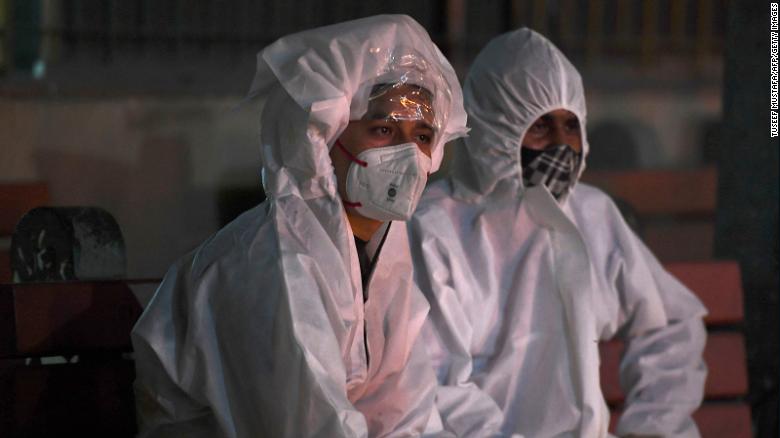
Photos: India's Covid-19 crisis
People wear protective suits while watching a relative's cremation in New Delhi on April 28. Their loved one died from Covid-19.
Hide Caption
1 of 30

Photos: India's Covid-19 crisis
A man performs the last rites of a deceased relative on April 30.
Hide Caption
2 of 30

Photos: India's Covid-19 crisis
A health worker collects a nasal swab sample to test for Covid-19 in Siliguri on April 30.
Hide Caption
3 of 30

Photos: India's Covid-19 crisis
Police personnel hold placards on their motorbikes during a Covid-19 awareness rally in Chennai on April 29.
Hide Caption
4 of 30

Photos: India's Covid-19 crisis
Workers prepare beds for a Covid-19 isolation center that was set up inside a stadium in Srinagar on April 27.
Hide Caption
5 of 30

Photos: India's Covid-19 crisis
Multiple funeral pyres burn in New Delhi on April 27.
Hide Caption
6 of 30

Photos: India's Covid-19 crisis
A health worker administers a Covid-19 test at a hospital in Noida on April 26.
Hide Caption
7 of 30

Photos: India's Covid-19 crisis
Umar Farooq mourns at the grave of his mother, a Covid-19 victim, in Srinagar.
Hide Caption
8 of 30

Photos: India's Covid-19 crisis
Health workers turn away an ambulance at the main entrance of the Lok Nayayak Jaiprakash Hospital in New Delhi on April 25.
Hide Caption
9 of 30

Photos: India's Covid-19 crisis
A worker digs a grave for a Covid-19 victim in Guwahati on April 25.
Hide Caption
10 of 30

Photos: India's Covid-19 crisis
A relative of a Covid-19 victim is consoled by another during a cremation in Jammu on April 25.
Hide Caption
11 of 30

Photos: India's Covid-19 crisis
People wait to refill their oxygen cylinders at a refilling station in Allahabad on April 24.
Hide Caption
12 of 30

Photos: India's Covid-19 crisis
A man inspects an intensive-care ward after a fire broke out at a Covid-19 hospital in Virar on April 23. At least 13 Covid-19 patients were killed in the fire.
Hide Caption
13 of 30

Photos: India's Covid-19 crisis
This aerial photo, taken with a drone, shows a mass cremation in New Delhi on April 22.
Hide Caption
14 of 30

Photos: India's Covid-19 crisis
Ambulances carrying Covid-19 patients line up outside a government hospital in Ahmedabad on April 22.
Hide Caption
15 of 30

Photos: India's Covid-19 crisis
People line up for vaccines at an indoor stadium in Guwahati on April 22.
Hide Caption
16 of 30

Photos: India's Covid-19 crisis
A relative of a Covid-19 victim breaks down during a cremation in New Delhi on April 20.
Hide Caption
17 of 30

Photos: India's Covid-19 crisis
Police officers patrol a deserted street in New Delhi on April 20. The capital city has been on lockdown because of Covid-19.
Hide Caption
18 of 30

Photos: India's Covid-19 crisis
Signs inform people that a vaccination center in Mumbai was out of vaccines on April 20.
Hide Caption
19 of 30

Photos: India's Covid-19 crisis
Migrant workers crowd the Kaushambi bus station on April 19. They were trying to return home after a lockdown order was announced in the capital.
Hide Caption
20 of 30

Photos: India's Covid-19 crisis
A woman waits to receive a Covid-19 vaccine in Mumbai on April 18.
Hide Caption
21 of 30

Photos: India's Covid-19 crisis
Relatives of a Covid-19 victim mourn for their loved one outside a government hospital in Ahmedabad on April 17.
Hide Caption
22 of 30

Photos: India's Covid-19 crisis
Migrant workers line up at a railway station to leave Mumbai ahead of a lockdown on April 14.
Hide Caption
23 of 30

Photos: India's Covid-19 crisis
People gather at a Srinagar mosque on the first day of Ramadan on April 14.
Hide Caption
24 of 30

Photos: India's Covid-19 crisis
A Hindu priest puts a face mask on an idol of the Goddess Ashapura during Navaratri celebrations in Beawar on April 13.
Hide Caption
25 of 30

Photos: India's Covid-19 crisis
Hindu holy men wade into the Ganges River during the Kumbh Mela religious festival on April 12. People also packed the streets of Haridwar for what is the largest religious pilgrimage on Earth, and the massive crowds created concern.
Hide Caption
26 of 30

Photos: India's Covid-19 crisis
Protesters wearing protective suits lie on a street near the Election Commission office in Kolkata on April 7. They were calling for a stop to the ongoing state legislative election and its associated campaign rallies.
Hide Caption
27 of 30

Photos: India's Covid-19 crisis
Children wear face shields at a martial-arts class in Kolkata on April 5.
Hide Caption
28 of 30

Photos: India's Covid-19 crisis
Supporters of the Bharatiya Janata Party wear masks of Prime Minister Narendra Modi during an election rally in Sonarpur on April 3.
Hide Caption
29 of 30

Photos: India's Covid-19 crisis
Social distancing was not easy to achieve as people walked through a busy market in Old Delhi on March 27.
Hide Caption
30 of 30
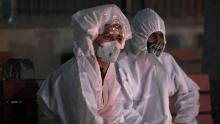
Photos: India's Covid-19 crisis
People wear protective suits while watching a relative's cremation in New Delhi on April 28. Their loved one died from Covid-19.
Hide Caption
1 of 30

Photos: India's Covid-19 crisis
A man performs the last rites of a deceased relative on April 30.
Hide Caption
2 of 30

Photos: India's Covid-19 crisis
A health worker collects a nasal swab sample to test for Covid-19 in Siliguri on April 30.
Hide Caption
3 of 30

Photos: India's Covid-19 crisis
Police personnel hold placards on their motorbikes during a Covid-19 awareness rally in Chennai on April 29.
Hide Caption
4 of 30

Photos: India's Covid-19 crisis
Workers prepare beds for a Covid-19 isolation center that was set up inside a stadium in Srinagar on April 27.
Hide Caption
5 of 30

Photos: India's Covid-19 crisis
Multiple funeral pyres burn in New Delhi on April 27.
Hide Caption
6 of 30

Photos: India's Covid-19 crisis
A health worker administers a Covid-19 test at a hospital in Noida on April 26.
Hide Caption
7 of 30

Photos: India's Covid-19 crisis
Umar Farooq mourns at the grave of his mother, a Covid-19 victim, in Srinagar.
Hide Caption
8 of 30

Photos: India's Covid-19 crisis
Health workers turn away an ambulance at the main entrance of the Lok Nayayak Jaiprakash Hospital in New Delhi on April 25.
Hide Caption
9 of 30

Photos: India's Covid-19 crisis
A worker digs a grave for a Covid-19 victim in Guwahati on April 25.
Hide Caption
10 of 30

Photos: India's Covid-19 crisis
A relative of a Covid-19 victim is consoled by another during a cremation in Jammu on April 25.
Hide Caption
11 of 30

Photos: India's Covid-19 crisis
People wait to refill their oxygen cylinders at a refilling station in Allahabad on April 24.
Hide Caption
12 of 30

Photos: India's Covid-19 crisis
A man inspects an intensive-care ward after a fire broke out at a Covid-19 hospital in Virar on April 23. At least 13 Covid-19 patients were killed in the fire.
Hide Caption
13 of 30

Photos: India's Covid-19 crisis
This aerial photo, taken with a drone, shows a mass cremation in New Delhi on April 22.
Hide Caption
14 of 30

Photos: India's Covid-19 crisis
Ambulances carrying Covid-19 patients line up outside a government hospital in Ahmedabad on April 22.
Hide Caption
15 of 30
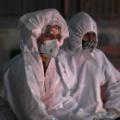
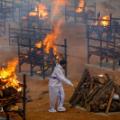
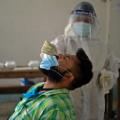
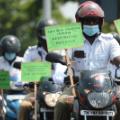

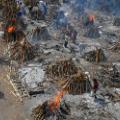
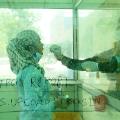
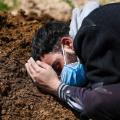
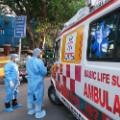
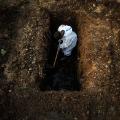
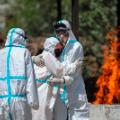
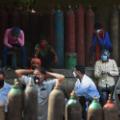
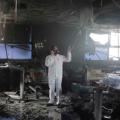

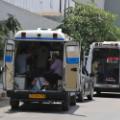
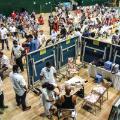
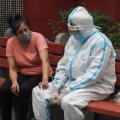
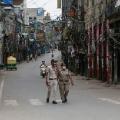
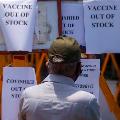
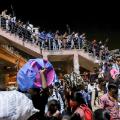
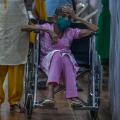
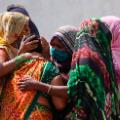
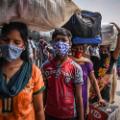
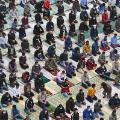
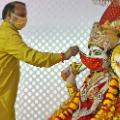
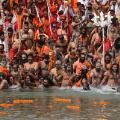
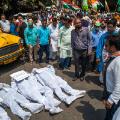
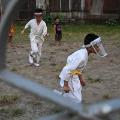
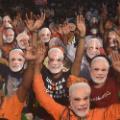
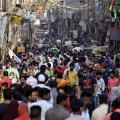
Modi's pandemic PR moves
With his name tied to these positive initiatives, a first wave that avoided the catastrophic caseload some experts feared, and a roaring pharmaceutical industry that had produced a homegrown vaccine, India's pandemic response was on track to be a PR win for Modi. The country was positioning itself to help other countries, having exported more than 66 million doses of vaccines, rather than be the one in need of aid.
"(India) has saved the world, entire humanity, from a major tragedy by effectively controlling coronavirus," Modi boasted at the World Economic Forum on January 28.
With many in India feeling the pandemic was over, there was a slower take-up of vaccines there than expected. About 300 million of India's 1.3 billion population are illiterate, meaning they may have had less ability to investigate what was going on for themselves.
"You can't blame people for thinking 'maybe the government knows best, maybe things are back to normal, maybe we should go out and live our normal lives,'" said Pradeep Taneja, an expert on Asian politics at the University of Melbourne and a fellow of the Australia India Institute.
But the pandemic was far from over. By February, cases were beginning to tick up. The BJP, however, still claimed India had "defeated Covid under the able, sensitive, committed and visionary leadership" of Modi.
On March 7, when the country reported about 18,000 new daily cases, the Health Minister Vardhan said India was in the "end game of the Covid-19 pandemic." And on March 30, a day before authorities reported more than 81,000 cases in a single day, Vardhan said: "The situation is under control."
"I think there was a premature sense of optimism among many that was probably unwarranted and in hindsight has ended up being quite deadly," he said.
Asia politics expert Taneja said: "Modi was complacent, even arrogant in thinking that India had succeeded when more developed countries, countries with much stronger health systems ... were struggling."
Fury over the second wave
As it became clear India's cases were spiraling, Modi stayed largely silent -- and a second nationwide lockdown that some expected never came. In a national address last month, he actively advocated against a nationwide lockdown.
Modi's apparent inaction prompted a wave of anger, spurring hundreds to share hashtags on Twitter such as #ModiMustResign and #ModiMadeDisaster. This week, the national vice president of the Indian Medical Association, Navjot Dahiya, called Modi a "super spreader" for holding political rallies and allowing millions of pilgrims to descend on Haridwar in northern India, to celebrate the Hindu festival Kumbh Mela, local media reported.
"People expect their governments to assure them that they are in charge and taking care of things ... but the government is almost missing in action," Pradeep Taneja said. "Now that India is facing the worse crisis, in my lifetime, certainly, where is the Prime Minister?"
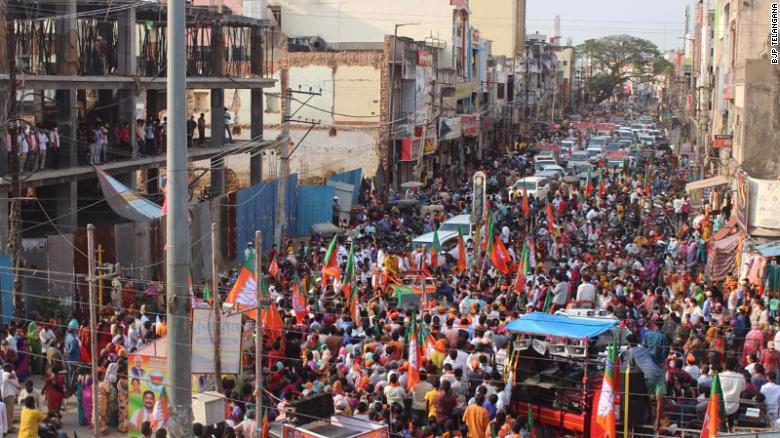
Members of Prime Minister Narendra Modi's Bharatiya Janata Party continue to hold rallies despite a devastating second wave of coronavirus gripping the country.
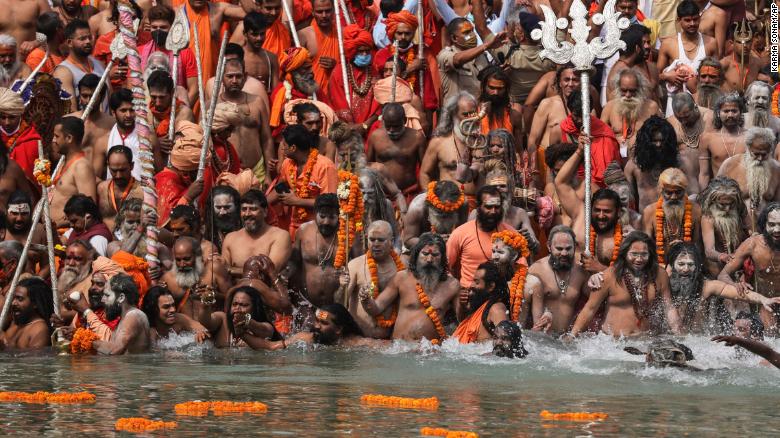
Naked Hindu holy men take dips in the Ganges River during Kumbh Mela, one of the most sacred pilgrimages in Hinduism, in Haridwar, northern state of Uttarakhand, India, on April 12, 2021.
This sort of criticism of Modi is remarkable in a country where he is seen by many as a "saintly" figure who always acts in the national interest, according to Asim Ali, a researcher at the Delhi-based Centre for Policy Research think tank. Modi's landslide 2019 re-election for a second five-year term gave him a sweeping mandate to push his Hindu nationalist agenda, in a country where 80% of the population is Hindu.
Despite this, experts believe Modi was too concerned about losing support to impose another nationwide lockdown.
When on March 24, 2020, Modi announced an unprecedented nationwide lockdown, India had only reported 519 cases. Buses and trains were brought to a halt, cross-state travel was banned, and most people weren't allowed out of their house unless they were buying groceries. Some called it the world's strictest lockdown.
That lockdown lasted months in some parts of the country. Although cases eventually fell after peaking in September, the elongated lockdown hurt India's millions of daily wage workers. The country's economy shrank by a record 24% in the second quarter, and GDP contracted by 6.9% overall last year.
This time, Modi has instead advocated for "micro containment zones," where restrictions are focused on areas of concern. It's been up to states to decide when and how to implement them. So far, at least eight of India's states and territories have some form of lockdown, ranging from a curfew in Karnataka and Gujurat states to a full lockdown in New Delhi.
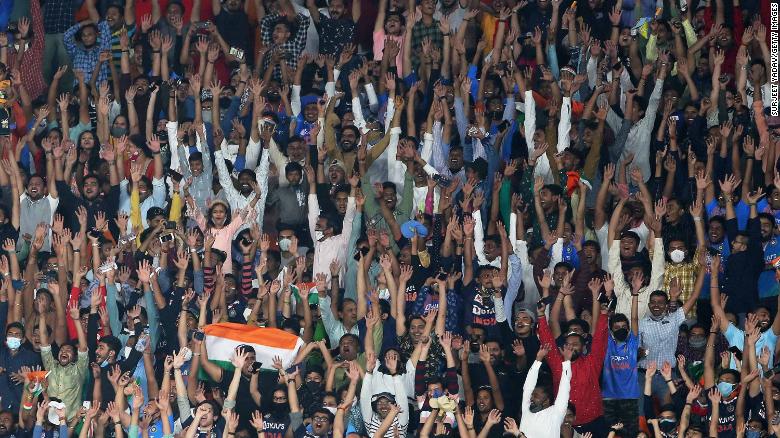
The crowd during the first T20 international match between India and England at Sardar Patel Stadium on March 12, 2021 in Ahmedabad, India.
Rajeev Sadanandan, a former bureaucrat in the health ministry of the state of Kerala and CEO of non-profit Health Systems Transformation Platform, said the reason for that was simple: "Last time, the lockdown was widely criticized as a failure" because it came at a huge economic cost and suffering to the poor.
The legislative elections held over the past month in Assam, West Bengal, Kerala and Tamil Nadu states, and Puducherry union territory, may have also been a factor. Two of those are BJP-run, while one -- West Bengal -- was a closely contested state. When asked why BJP had continued to hold rallies, the party's spokesman Taneja said the "autonomous" Election Commission of India allowed election events to proceed.
Michael Head, a senior research fellow in global health at the University of Southampton's Clinical Informatics Research Unit, said aside from restricting gatherings and having clearer messaging, the government could have curtailed cross-country travel -- as it did during the first lockdown.
Lack of preparedness
As India enjoyed a relative period of calm at the beginning of this year, Modi could have been preparing his country for another battle with Covid-19, patching up health care gaps in preparation for a possible future outbreak.
Both the US and the UK were hit harder by their second waves than their first, despite warnings from experts. In the US, White House trade adviser Peter Navarro said last June the US was preparing for a second wave by "filling the stockpile."
Despite local media in India reporting officials had warned of looming oxygen shortages in April last year, and then again in November, the government didn't appear to take action. Pradeep Taneja said it was "arrogant" for Modi to hold campaign rallies, rather than safeguarding the country's oxygen supplies.
The criticisms of the lack of preparedness in India's government, however, go beyond Modi.
In April, local media outlet The Caravan reported the country's national scientific taskforce -- a group intended to advise the central government on how to respond to the pandemic -- did not meet during February and March, as daily cases increased more than sixfold. CNN has contacted the chairman of the taskforce, V. K. Paul, for comment.
And India's health system has been underfunded for years. In 2018, India spent 3.5% of its GDP on health care, according to World Bank figures -- well below the world average of 10%, or the 17% spent in the US, which also battled to contain its Covid-19 outbreak. India has 0.9 physicians per 1,000 people, well under the world average of 1.6, or the US's 2.6, according to the World Bank.
As human rights activist Harsh Mander puts it, India had "starved" its public health systems for decades -- long before Modi's time in office.
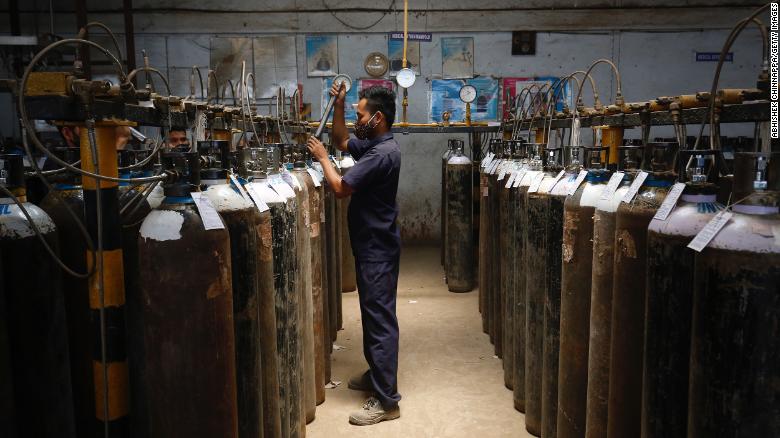
An employee fills oxygen cylinders inside an oxygen filling centre on April 28, 2021 in Bengaluru, India.
Even before hospitals were overwhelmed, this impacted India's ability to monitor the virus. According to a paper published in February, India had only sequenced 0.06% of its reported cases. Its rate is lower than neighbors Sri Lanka and Bangladesh.
Sadanandan, the former Kerela health official, said most parts of India did not have an adequate surveillance system to keep track of the outbreak. But to him, that was a state-level failing -- not a central government one -- as health is a state issue. "I'm not surprised by what has happened because we've seen this happen for many epidemics," he noted.
Was it all Modi's fault?
To critics, while state leaders have some blame to bear, ultimately if Modi is going to take credit for India's pandemic wins, he also needs to take responsibility for its pandemic failings.
His extraordinary popularity means his actions have power -- so underplaying the risk of the pandemic could have influenced how millions of his followers across the country acted. By the start of this year, many people in India stopped wearing masks and many social distancing measures had fallen by the wayside.
It's too early to know if the grim scenes India is witnessing will tarnish Modi's reputation. There are still three years before the next general election, and Modi has no clear challenger.
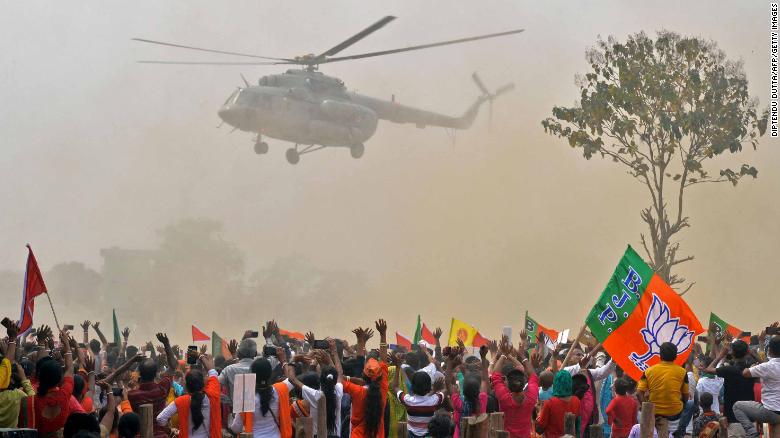
Supporters of Bharatiya Janata Party (BJP) wave towards a helicopter carrying Indian Prime Minister Narendra Modi upon his arrival at a public rally at Kawakhali on the outskirts of Siliguri on April 10, 2021.
But Taneja expects to see a "significant reevaluation of the Modi government by the Indian public."
"No single person can be blamed for the catastrophe that India finds itself in. But if you are the Prime Minister, clearly the primary responsibility falls on you," he said.
Barkha Dutt, a Washington Post columnist whose father died from Covid a few days ago, said her father's last words were: "I'm choking. Please give me treatment." She felt angry and betrayed that as people across India battled the virus, politicians were still holding rallies. Dutt described Modi's government as "callousness," "tone deaf" and in "complete denial."
She said the health care system had clearly collapsed -- but that wasn't the fault of doctors, hospitals or frontline workers.
"We've been failed by the government that did not think to put in place a contingency plan for the second wave," she said. "Is anyone going to take accountability for the thousands that are dying?"
Esha Mitra and Manveena Suri contributed reporting from New Delhi. Akanksha Sharma contributed reporting from Hong Kong.
MODI MASS MURDERER
SACRIFICING TO KALI
By Julia Hollingsworth, CNN
Sat May 1, 2021
(CNN) On April 17, ahead of a state election, a maskless Prime Minister Narendra Modi boasted to a sea of cheering supporters: "I've never ever seen such huge crowds at a rally."
His country was on the brink of a humanitarian crisis. That day, India recorded more than 261,000 new coronavirus cases -- more than many countries have seen during the entire pandemic.
And it was only going to get worse. Each day since April 22, the country has reported more than 300,000 new cases -- at times, up to half of the daily cases reported globally. The capital New Delhi is now running out of wood for cremations. Hospitals are full and lacking oxygen. Only 2% of the population has been fully vaccinated. Foreign leaders are now rushing to India's aid.
While Modi's Hindu nationalist Bharatiya Janata Party (BJP) spokesman Narendra Taneja told CNN this week that responsibility for India's second wave belonged "first and foremost" to the government, he maintained the crisis could not have been foreseen -- despite countless countries being battered by second waves as new variants emerged globally.
Others in Modi's orbit have argued state governments are to blame for not imposing regional lockdowns and mismanaging their health care systems. Last weekend, Health Minister Harsh Vardhan said oxygen shortages at hospitals were a problem not of supply but distribution, which he claimed was the responsibility of state governments.
But many in India believe responsibility lies with Modi and his Hindu nationalist government, which not only didn't prepare for a second wave but also encouraged mass gatherings at Hindu festivals and political rallies, including in a closely contested battleground state.
"The government has failed us all," Priyanka Gandhi Vadra, the general secretary of opposition party Indian National Congress, said in a statement this week. "Even those of us who oppose and fight them could not have foreseen a complete abdication of leadership and governance at a time as devastating as this."
Photos: India's Covid-19 crisis
People line up for vaccines at an indoor stadium in Guwahati on April 22.
Hide Caption
16 of 30
Photos: India's Covid-19 crisis
A relative of a Covid-19 victim breaks down during a cremation in New Delhi on April 20.
Hide Caption
17 of 30
Photos: India's Covid-19 crisis
Police officers patrol a deserted street in New Delhi on April 20. The capital city has been on lockdown because of Covid-19.
Hide Caption
18 of 30
Photos: India's Covid-19 crisis
Signs inform people that a vaccination center in Mumbai was out of vaccines on April 20.
Hide Caption
19 of 30
Photos: India's Covid-19 crisis
Migrant workers crowd the Kaushambi bus station on April 19. They were trying to return home after a lockdown order was announced in the capital.
Hide Caption
20 of 30
Photos: India's Covid-19 crisis
A woman waits to receive a Covid-19 vaccine in Mumbai on April 18.
Hide Caption
21 of 30
Photos: India's Covid-19 crisis
Relatives of a Covid-19 victim mourn for their loved one outside a government hospital in Ahmedabad on April 17.
Hide Caption
22 of 30
Photos: India's Covid-19 crisis
Migrant workers line up at a railway station to leave Mumbai ahead of a lockdown on April 14.
Hide Caption
23 of 30
Photos: India's Covid-19 crisis
People gather at a Srinagar mosque on the first day of Ramadan on April 14.
Hide Caption
24 of 30
Photos: India's Covid-19 crisis
A Hindu priest puts a face mask on an idol of the Goddess Ashapura during Navaratri celebrations in Beawar on April 13.
Hide Caption
25 of 30
Photos: India's Covid-19 crisis
Hindu holy men wade into the Ganges River during the Kumbh Mela religious festival on April 12. People also packed the streets of Haridwar for what is the largest religious pilgrimage on Earth, and the massive crowds created concern.
Hide Caption
26 of 30
Photos: India's Covid-19 crisis
Protesters wearing protective suits lie on a street near the Election Commission office in Kolkata on April 7. They were calling for a stop to the ongoing state legislative election and its associated campaign rallies.
Hide Caption
27 of 30
Photos: India's Covid-19 crisis
Children wear face shields at a martial-arts class in Kolkata on April 5.
Hide Caption
28 of 30
Photos: India's Covid-19 crisis
Supporters of the Bharatiya Janata Party wear masks of Prime Minister Narendra Modi during an election rally in Sonarpur on April 3.
Hide Caption
29 of 30
Photos: India's Covid-19 crisis
Social distancing was not easy to achieve as people walked through a busy market in Old Delhi on March 27.
Hide Caption
30 of 30

Photos: India's Covid-19 crisis
People wear protective suits while watching a relative's cremation in New Delhi on April 28. Their loved one died from Covid-19.
Hide Caption
1 of 30
Photos: India's Covid-19 crisis
A man performs the last rites of a deceased relative on April 30.
Hide Caption
2 of 30
Photos: India's Covid-19 crisis
A health worker collects a nasal swab sample to test for Covid-19 in Siliguri on April 30.
Hide Caption
3 of 30
Photos: India's Covid-19 crisis
Police personnel hold placards on their motorbikes during a Covid-19 awareness rally in Chennai on April 29.
Hide Caption
4 of 30
Photos: India's Covid-19 crisis
Workers prepare beds for a Covid-19 isolation center that was set up inside a stadium in Srinagar on April 27.
Hide Caption
5 of 30
Photos: India's Covid-19 crisis
Multiple funeral pyres burn in New Delhi on April 27.
Hide Caption
6 of 30
Photos: India's Covid-19 crisis
A health worker administers a Covid-19 test at a hospital in Noida on April 26.
Hide Caption
7 of 30
Photos: India's Covid-19 crisis
Umar Farooq mourns at the grave of his mother, a Covid-19 victim, in Srinagar.
Hide Caption
8 of 30
Photos: India's Covid-19 crisis
Health workers turn away an ambulance at the main entrance of the Lok Nayayak Jaiprakash Hospital in New Delhi on April 25.
Hide Caption
9 of 30
Photos: India's Covid-19 crisis
A worker digs a grave for a Covid-19 victim in Guwahati on April 25.
Hide Caption
10 of 30
Photos: India's Covid-19 crisis
A relative of a Covid-19 victim is consoled by another during a cremation in Jammu on April 25.
Hide Caption
11 of 30
Photos: India's Covid-19 crisis
People wait to refill their oxygen cylinders at a refilling station in Allahabad on April 24.
Hide Caption
12 of 30
Photos: India's Covid-19 crisis
A man inspects an intensive-care ward after a fire broke out at a Covid-19 hospital in Virar on April 23. At least 13 Covid-19 patients were killed in the fire.
Hide Caption
13 of 30
Photos: India's Covid-19 crisis
This aerial photo, taken with a drone, shows a mass cremation in New Delhi on April 22.
Hide Caption
14 of 30
Photos: India's Covid-19 crisis
Ambulances carrying Covid-19 patients line up outside a government hospital in Ahmedabad on April 22.
Hide Caption
15 of 30
Photos: India's Covid-19 crisis
People line up for vaccines at an indoor stadium in Guwahati on April 22.
Hide Caption
16 of 30
Photos: India's Covid-19 crisis
A relative of a Covid-19 victim breaks down during a cremation in New Delhi on April 20.
Hide Caption
17 of 30
Photos: India's Covid-19 crisis
Police officers patrol a deserted street in New Delhi on April 20. The capital city has been on lockdown because of Covid-19.
Hide Caption
18 of 30
Photos: India's Covid-19 crisis
Signs inform people that a vaccination center in Mumbai was out of vaccines on April 20.
Hide Caption
19 of 30
Photos: India's Covid-19 crisis
Migrant workers crowd the Kaushambi bus station on April 19. They were trying to return home after a lockdown order was announced in the capital.
Hide Caption
20 of 30
Photos: India's Covid-19 crisis
A woman waits to receive a Covid-19 vaccine in Mumbai on April 18.
Hide Caption
21 of 30
Photos: India's Covid-19 crisis
Relatives of a Covid-19 victim mourn for their loved one outside a government hospital in Ahmedabad on April 17.
Hide Caption
22 of 30
Photos: India's Covid-19 crisis
Migrant workers line up at a railway station to leave Mumbai ahead of a lockdown on April 14.
Hide Caption
23 of 30
Photos: India's Covid-19 crisis
People gather at a Srinagar mosque on the first day of Ramadan on April 14.
Hide Caption
24 of 30
Photos: India's Covid-19 crisis
A Hindu priest puts a face mask on an idol of the Goddess Ashapura during Navaratri celebrations in Beawar on April 13.
Hide Caption
25 of 30
Photos: India's Covid-19 crisis
Hindu holy men wade into the Ganges River during the Kumbh Mela religious festival on April 12. People also packed the streets of Haridwar for what is the largest religious pilgrimage on Earth, and the massive crowds created concern.
Hide Caption
26 of 30
Photos: India's Covid-19 crisis
Protesters wearing protective suits lie on a street near the Election Commission office in Kolkata on April 7. They were calling for a stop to the ongoing state legislative election and its associated campaign rallies.
Hide Caption
27 of 30
Photos: India's Covid-19 crisis
Children wear face shields at a martial-arts class in Kolkata on April 5.
Hide Caption
28 of 30
Photos: India's Covid-19 crisis
Supporters of the Bharatiya Janata Party wear masks of Prime Minister Narendra Modi during an election rally in Sonarpur on April 3.
Hide Caption
29 of 30
Photos: India's Covid-19 crisis
Social distancing was not easy to achieve as people walked through a busy market in Old Delhi on March 27.
Hide Caption
30 of 30

Photos: India's Covid-19 crisis
People wear protective suits while watching a relative's cremation in New Delhi on April 28. Their loved one died from Covid-19.
Hide Caption
1 of 30
Photos: India's Covid-19 crisis
A man performs the last rites of a deceased relative on April 30.
Hide Caption
2 of 30
Photos: India's Covid-19 crisis
A health worker collects a nasal swab sample to test for Covid-19 in Siliguri on April 30.
Hide Caption
3 of 30
Photos: India's Covid-19 crisis
Police personnel hold placards on their motorbikes during a Covid-19 awareness rally in Chennai on April 29.
Hide Caption
4 of 30
Photos: India's Covid-19 crisis
Workers prepare beds for a Covid-19 isolation center that was set up inside a stadium in Srinagar on April 27.
Hide Caption
5 of 30
Photos: India's Covid-19 crisis
Multiple funeral pyres burn in New Delhi on April 27.
Hide Caption
6 of 30
Photos: India's Covid-19 crisis
A health worker administers a Covid-19 test at a hospital in Noida on April 26.
Hide Caption
7 of 30
Photos: India's Covid-19 crisis
Umar Farooq mourns at the grave of his mother, a Covid-19 victim, in Srinagar.
Hide Caption
8 of 30
Photos: India's Covid-19 crisis
Health workers turn away an ambulance at the main entrance of the Lok Nayayak Jaiprakash Hospital in New Delhi on April 25.
Hide Caption
9 of 30
Photos: India's Covid-19 crisis
A worker digs a grave for a Covid-19 victim in Guwahati on April 25.
Hide Caption
10 of 30
Photos: India's Covid-19 crisis
A relative of a Covid-19 victim is consoled by another during a cremation in Jammu on April 25.
Hide Caption
11 of 30
Photos: India's Covid-19 crisis
People wait to refill their oxygen cylinders at a refilling station in Allahabad on April 24.
Hide Caption
12 of 30
Photos: India's Covid-19 crisis
A man inspects an intensive-care ward after a fire broke out at a Covid-19 hospital in Virar on April 23. At least 13 Covid-19 patients were killed in the fire.
Hide Caption
13 of 30
Photos: India's Covid-19 crisis
This aerial photo, taken with a drone, shows a mass cremation in New Delhi on April 22.
Hide Caption
14 of 30
Photos: India's Covid-19 crisis
Ambulances carrying Covid-19 patients line up outside a government hospital in Ahmedabad on April 22.
Hide Caption
15 of 30






























Modi's pandemic PR moves
Modi has been keen to tie himself to positive aspects of India's pandemic responses.
Vaccinated Indians receive a certificate with his face on it. The Covid relief fund, a charitable trust which gathers voluntary contributions to help support those affected, is named PM Cares -- an acronym for Prime Minister's Citizen Assistance and Relief in Emergency Situations Fund. It also bears Modi's face on its official website.
Vaccinated Indians receive a certificate with his face on it. The Covid relief fund, a charitable trust which gathers voluntary contributions to help support those affected, is named PM Cares -- an acronym for Prime Minister's Citizen Assistance and Relief in Emergency Situations Fund. It also bears Modi's face on its official website.
With his name tied to these positive initiatives, a first wave that avoided the catastrophic caseload some experts feared, and a roaring pharmaceutical industry that had produced a homegrown vaccine, India's pandemic response was on track to be a PR win for Modi. The country was positioning itself to help other countries, having exported more than 66 million doses of vaccines, rather than be the one in need of aid.
"(India) has saved the world, entire humanity, from a major tragedy by effectively controlling coronavirus," Modi boasted at the World Economic Forum on January 28.
With many in India feeling the pandemic was over, there was a slower take-up of vaccines there than expected. About 300 million of India's 1.3 billion population are illiterate, meaning they may have had less ability to investigate what was going on for themselves.
"You can't blame people for thinking 'maybe the government knows best, maybe things are back to normal, maybe we should go out and live our normal lives,'" said Pradeep Taneja, an expert on Asian politics at the University of Melbourne and a fellow of the Australia India Institute.
But the pandemic was far from over. By February, cases were beginning to tick up. The BJP, however, still claimed India had "defeated Covid under the able, sensitive, committed and visionary leadership" of Modi.
On March 7, when the country reported about 18,000 new daily cases, the Health Minister Vardhan said India was in the "end game of the Covid-19 pandemic." And on March 30, a day before authorities reported more than 81,000 cases in a single day, Vardhan said: "The situation is under control."
Yet mutations had been circulating overseas for months, and epidemiologists in India believed another wave was coming. While the second wave was inevitable, its size took everyone by surprise, said Ramanan Laxminarayan, an economist and epidemiologist at Princeton University who is in New Delhi.
"I think there was a premature sense of optimism among many that was probably unwarranted and in hindsight has ended up being quite deadly," he said.
Asia politics expert Taneja said: "Modi was complacent, even arrogant in thinking that India had succeeded when more developed countries, countries with much stronger health systems ... were struggling."
Fury over the second wave
As it became clear India's cases were spiraling, Modi stayed largely silent -- and a second nationwide lockdown that some expected never came. In a national address last month, he actively advocated against a nationwide lockdown.
Modi's apparent inaction prompted a wave of anger, spurring hundreds to share hashtags on Twitter such as #ModiMustResign and #ModiMadeDisaster. This week, the national vice president of the Indian Medical Association, Navjot Dahiya, called Modi a "super spreader" for holding political rallies and allowing millions of pilgrims to descend on Haridwar in northern India, to celebrate the Hindu festival Kumbh Mela, local media reported.
"People expect their governments to assure them that they are in charge and taking care of things ... but the government is almost missing in action," Pradeep Taneja said. "Now that India is facing the worse crisis, in my lifetime, certainly, where is the Prime Minister?"

Members of Prime Minister Narendra Modi's Bharatiya Janata Party continue to hold rallies despite a devastating second wave of coronavirus gripping the country.

Naked Hindu holy men take dips in the Ganges River during Kumbh Mela, one of the most sacred pilgrimages in Hinduism, in Haridwar, northern state of Uttarakhand, India, on April 12, 2021.
This sort of criticism of Modi is remarkable in a country where he is seen by many as a "saintly" figure who always acts in the national interest, according to Asim Ali, a researcher at the Delhi-based Centre for Policy Research think tank. Modi's landslide 2019 re-election for a second five-year term gave him a sweeping mandate to push his Hindu nationalist agenda, in a country where 80% of the population is Hindu.
Despite this, experts believe Modi was too concerned about losing support to impose another nationwide lockdown.
When on March 24, 2020, Modi announced an unprecedented nationwide lockdown, India had only reported 519 cases. Buses and trains were brought to a halt, cross-state travel was banned, and most people weren't allowed out of their house unless they were buying groceries. Some called it the world's strictest lockdown.
That lockdown lasted months in some parts of the country. Although cases eventually fell after peaking in September, the elongated lockdown hurt India's millions of daily wage workers. The country's economy shrank by a record 24% in the second quarter, and GDP contracted by 6.9% overall last year.
This time, Modi has instead advocated for "micro containment zones," where restrictions are focused on areas of concern. It's been up to states to decide when and how to implement them. So far, at least eight of India's states and territories have some form of lockdown, ranging from a curfew in Karnataka and Gujurat states to a full lockdown in New Delhi.

The crowd during the first T20 international match between India and England at Sardar Patel Stadium on March 12, 2021 in Ahmedabad, India.
Rajeev Sadanandan, a former bureaucrat in the health ministry of the state of Kerala and CEO of non-profit Health Systems Transformation Platform, said the reason for that was simple: "Last time, the lockdown was widely criticized as a failure" because it came at a huge economic cost and suffering to the poor.
The legislative elections held over the past month in Assam, West Bengal, Kerala and Tamil Nadu states, and Puducherry union territory, may have also been a factor. Two of those are BJP-run, while one -- West Bengal -- was a closely contested state. When asked why BJP had continued to hold rallies, the party's spokesman Taneja said the "autonomous" Election Commission of India allowed election events to proceed.
Michael Head, a senior research fellow in global health at the University of Southampton's Clinical Informatics Research Unit, said aside from restricting gatherings and having clearer messaging, the government could have curtailed cross-country travel -- as it did during the first lockdown.
Lack of preparedness
As India enjoyed a relative period of calm at the beginning of this year, Modi could have been preparing his country for another battle with Covid-19, patching up health care gaps in preparation for a possible future outbreak.
Pradeep Taneja said there was "criminal negligence on the part of the government" to not prepare for another wave despite knowing other countries with better health care systems had experienced multiple waves.
Both the US and the UK were hit harder by their second waves than their first, despite warnings from experts. In the US, White House trade adviser Peter Navarro said last June the US was preparing for a second wave by "filling the stockpile."
Despite local media in India reporting officials had warned of looming oxygen shortages in April last year, and then again in November, the government didn't appear to take action. Pradeep Taneja said it was "arrogant" for Modi to hold campaign rallies, rather than safeguarding the country's oxygen supplies.
The criticisms of the lack of preparedness in India's government, however, go beyond Modi.
In April, local media outlet The Caravan reported the country's national scientific taskforce -- a group intended to advise the central government on how to respond to the pandemic -- did not meet during February and March, as daily cases increased more than sixfold. CNN has contacted the chairman of the taskforce, V. K. Paul, for comment.
And India's health system has been underfunded for years. In 2018, India spent 3.5% of its GDP on health care, according to World Bank figures -- well below the world average of 10%, or the 17% spent in the US, which also battled to contain its Covid-19 outbreak. India has 0.9 physicians per 1,000 people, well under the world average of 1.6, or the US's 2.6, according to the World Bank.
As human rights activist Harsh Mander puts it, India had "starved" its public health systems for decades -- long before Modi's time in office.

An employee fills oxygen cylinders inside an oxygen filling centre on April 28, 2021 in Bengaluru, India.
Even before hospitals were overwhelmed, this impacted India's ability to monitor the virus. According to a paper published in February, India had only sequenced 0.06% of its reported cases. Its rate is lower than neighbors Sri Lanka and Bangladesh.
Sadanandan, the former Kerela health official, said most parts of India did not have an adequate surveillance system to keep track of the outbreak. But to him, that was a state-level failing -- not a central government one -- as health is a state issue. "I'm not surprised by what has happened because we've seen this happen for many epidemics," he noted.
Was it all Modi's fault?
To critics, while state leaders have some blame to bear, ultimately if Modi is going to take credit for India's pandemic wins, he also needs to take responsibility for its pandemic failings.
His extraordinary popularity means his actions have power -- so underplaying the risk of the pandemic could have influenced how millions of his followers across the country acted. By the start of this year, many people in India stopped wearing masks and many social distancing measures had fallen by the wayside.
It's too early to know if the grim scenes India is witnessing will tarnish Modi's reputation. There are still three years before the next general election, and Modi has no clear challenger.

Supporters of Bharatiya Janata Party (BJP) wave towards a helicopter carrying Indian Prime Minister Narendra Modi upon his arrival at a public rally at Kawakhali on the outskirts of Siliguri on April 10, 2021.
But Taneja expects to see a "significant reevaluation of the Modi government by the Indian public."
"No single person can be blamed for the catastrophe that India finds itself in. But if you are the Prime Minister, clearly the primary responsibility falls on you," he said.
Barkha Dutt, a Washington Post columnist whose father died from Covid a few days ago, said her father's last words were: "I'm choking. Please give me treatment." She felt angry and betrayed that as people across India battled the virus, politicians were still holding rallies. Dutt described Modi's government as "callousness," "tone deaf" and in "complete denial."
She said the health care system had clearly collapsed -- but that wasn't the fault of doctors, hospitals or frontline workers.
"We've been failed by the government that did not think to put in place a contingency plan for the second wave," she said. "Is anyone going to take accountability for the thousands that are dying?"
Esha Mitra and Manveena Suri contributed reporting from New Delhi. Akanksha Sharma contributed reporting from Hong Kong.
